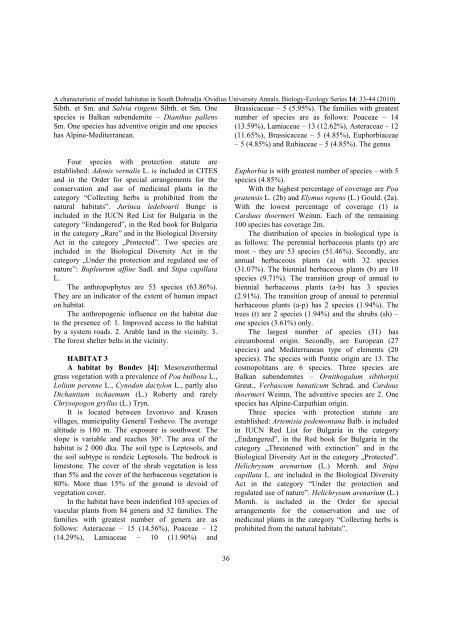VOLUM OMAGIAL - Facultatea de Ştiinţe ale Naturii şi Ştiinţe Agricole
VOLUM OMAGIAL - Facultatea de Ştiinţe ale Naturii şi Ştiinţe Agricole
VOLUM OMAGIAL - Facultatea de Ştiinţe ale Naturii şi Ştiinţe Agricole
You also want an ePaper? Increase the reach of your titles
YUMPU automatically turns print PDFs into web optimized ePapers that Google loves.
A characteristic of mo<strong>de</strong>l habitatas in South Dobrudja /Ovidius University Annals, Biology-Ecology Series 14: 33-44 (2010)<br />
Sibth. et Sm. and Salvia ringens Sibth. et Sm. One<br />
species is Balkan suben<strong>de</strong>mite – Dianthus pallens<br />
Sm. One species has adventive origin and one species<br />
has Alpine-Mediterranean.<br />
Four species with protection statute are<br />
established: Adonis vernalis L. is inclu<strong>de</strong>d in CITES<br />
and in the Or<strong>de</strong>r for special arrangements for the<br />
conservation and use of medicinal plants in the<br />
category “Collecting herbs is prohibited from the<br />
natural habitats”. Jurinea le<strong>de</strong>bourii Bunge is<br />
inclu<strong>de</strong>d in the IUCN Red List for Bulgaria in the<br />
category “Endangered”, in the Red book for Bulgaria<br />
in the category „Rare” and in the Biological Diversity<br />
Act in the category „Protected”. Two species are<br />
inclu<strong>de</strong>d in the Biological Diversity Act in the<br />
category „Un<strong>de</strong>r the protection and regulated use of<br />
nature”: Bupleurum affine Sadl. and Stipa capillata<br />
L.<br />
The anthropophytes are 53 species (63.86%).<br />
They are an indicator of the extent of human impact<br />
on habitat.<br />
The anthropogenic influence on the habitat due<br />
to the presence of: 1. Improved access to the habitat<br />
by a system roads. 2. Arable land in the vicinity. 3.<br />
The forest shelter belts in the vicinity.<br />
HABITAT 3<br />
A habitat by Bon<strong>de</strong>v [4]: Mesoxerothermal<br />
grass vegetation with a prev<strong>ale</strong>nce of Poa bulbosa L.,<br />
Lolium perenne L., Cynodon dactylon L., partly also<br />
Dichantium ischaemum (L.) Roberty and rarely<br />
Chrysopogon gryllus (L.) Tryn.<br />
It is located between Izvorovo and Krasen<br />
villages, municipality General Toshevo. The average<br />
altitu<strong>de</strong> is 180 m. The exposure is southwest. The<br />
slope is variable and reaches 30°. The area of the<br />
habitat is 2 000 dka. The soil type is Leptosols, and<br />
the soil subtype is rendzic Leptosols. The bedrock is<br />
limestone. The cover of the shrub vegetation is less<br />
than 5% and the cover of the herbaceous vegetation is<br />
80%. More than 15% of the ground is <strong>de</strong>void of<br />
vegetation cover.<br />
In the habitat have been in<strong>de</strong>tified 103 species of<br />
vascular plants from 84 genera and 32 families. The<br />
families with greatest number of genera are as<br />
follows: Asteraceae – 15 (14.56%), Poaceae – 12<br />
(14.29%), Lamiaceae – 10 (11.90%) and<br />
36<br />
Brassicaceae – 5 (5.95%). The families with greatest<br />
number of species are as follows: Poaceae – 14<br />
(13.59%), Lamiaceae – 13 (12.62%), Asteraceae – 12<br />
(11.65%), Brassicaceae – 5 (4.85%), Euphorbiaceae<br />
– 5 (4.85%) and Rubiaceae – 5 (4.85%). The genus<br />
Euphorbia is with greatest number of species – with 5<br />
species (4.85%).<br />
With the highest percentage of coverage are Poa<br />
pratensis L. (2b) and Elymus repens (L.) Gould. (2а).<br />
With the lowest percentage of coverage (1) is<br />
Carduus thoermeri Weinm. Each of the remaining<br />
100 species has coverage 2m.<br />
The distribution of species in biological type is<br />
as follows: The perennial herbaceous plants (p) are<br />
most – they are 53 species (51.46%). Secondly, are<br />
annual herbaceous plants (a) with 32 species<br />
(31.07%). The biennial herbaceous plants (b) are 10<br />
species (9.71%). The transition group of annual to<br />
biennial herbaceous plants (a-b) has 3 species<br />
(2.91%). The transition group of annual to perennial<br />
herbaceous plants (a-р) has 2 species (1.94%). The<br />
trees (t) are 2 species (1.94%) and the shrubs (sh) –<br />
one species (3.61%) only.<br />
The largest number of species (31) has<br />
circumboreal origin. Secondly, are European (27<br />
species) and Mediterranean type of elements (20<br />
species). The species with Pontic origin are 13. The<br />
cosmopolitans are 6 species. Three species are<br />
Balkan suben<strong>de</strong>mites – Ornithogalum sibthorpii<br />
Greut., Verbascum banaticum Schrad. and Carduus<br />
thoermeri Weinm. The adventive species are 2. One<br />
species has Alpine-Carpathian origin.<br />
Three species with protection statute are<br />
established: Artemisia pe<strong>de</strong>montana Balb. is inclu<strong>de</strong>d<br />
in IUCN Red List for Bulgaria in the category<br />
„Endangered”, in the Red book for Bulgaria in the<br />
category „Threatened with extinction” and in the<br />
Biological Diversity Act in the category „Protected”.<br />
Helichrysum arenarium (L.) Mornh. and Stipa<br />
capillata L. are inclu<strong>de</strong>d in the Biological Diversity<br />
Act in the category “Un<strong>de</strong>r the protection and<br />
regulated use of nature”. Helichrysum arenarium (L.)<br />
Mornh. is inclu<strong>de</strong>d in the Or<strong>de</strong>r for special<br />
arrangements for the conservation and use of<br />
medicinal plants in the category “Collecting herbs is<br />
prohibited from the natural habitats”.





